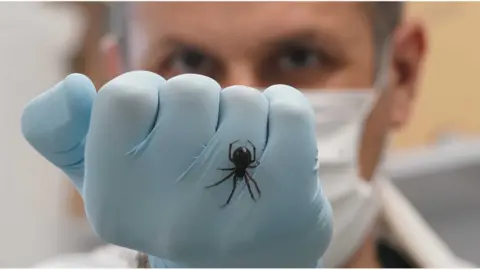False widow spiders: Mum's warning after baby is bitten
 RTÉ
RTÉA mother whose baby was bitten by a noble false widow spider has urged people to be aware of the dangers of the invasive species.
Sarah Jane Dennelly was speaking after a study revealed that the venom from false widow spiders is 230 times stronger than native Irish spiders.
Scientists from NUI Galway's Ryan Institute found the false widow can also adapt its attacking behaviour.
It can win battles against other spiders as well as shrews and bats.
Now the research team in Galway intends to study what effect the invasive species is having on native spiders.
The false widow is said to have a bite on a par with a wasp's sting.
But some people can have very strong reactions to its venom.
 PA Media
PA MediaMs Dennehy's 15-week-old son, Charlie, was bitten at their home in Shanagarry, County Cork, in the Republic of Ireland.
He became so ill that he had to be treated at the emergency department at the local hospital. His mother said the incident was traumatising.
"Charlie was lying on his mat and all of a sudden he went apocalyptic - he had a real bout of purple screaming," she said.
"I stripped off his trousers and his lower left leg was swollen, it was bright red and there were three bites.
"Then I stripped off his top and a noble false widow spider crawled out from behind his ear."
Ms Dennehy gave her son paracetamol and took him to the GP.
He seemed to have settled but within hours, once the painkiller had worn off, he became inconsolable again, she said.
"We ended up taking him to accident and emergency. By 22:30 - 11 hours after he was bitten - the effects of the venom wore off," she said.
Ms Dennehy said she had been in touch with the research team at NUI Galway and was monitoring her son against the possibility of a bacterial infection following the bites.
"I want people to be aware that there are venomous spiders in Ireland and the UK," she said.
"These false widow spiders are decimating the native spider population. So please do not kill every spider in the garden. It's about having an awareness and not interacting with them."
Over the past five years, the team at the university's Venom Systems Lab has studied the spiders' venom, bite symptoms, ecology and behaviour.
 PA Media
PA MediaDr Michel Dugon, senior author of the new research, said the noble false widow was very invasive and very good at conquering new territory.
"This study is another important step to understand the true impact this species has on the ecosystems it invades throughout the world," he said.
The false widow - steatoda nobilis - is originally from Madeira and the Canary Islands but has spread rapidly in Ireland in recent years.
The researchers set out to investigate why the spider had been so successful at spreading across the world.
They found that the strength of its venom explained how it could tackle larger creatures such as spiders, lizards, shrews and even bats.
The study also found that noble false widows could make calculated decisions on whether to attack large or small prey depending on how much venom was left in their venom glands.
Scientists also demonstrated that in a battle the noble false widow did not inject its venom randomly, but instead targeted the body parts of its enemy, where the poison would be most effective.
Overall, the noble false widow spider killed and ate 95% of its opponents over the course of the NUI study.
"The venom of the false widow kills at much smaller doses," said Dr Dugon.
"Essentially, they have a chemical arsenal that is a lot stronger than native spiders. That gives them a competitive advantage because they are more toxic.
"So they can kill more prey using less venom and that means that they don't have to spend as much time and as much energy to try and produce venom."
'Taking the road west'
Dr Dugon said the spiders were extremely common on the east coast of Ireland from Belfast to Wexford and were moving steadily west, mainly following the main roads.
"They live in and around buildings. They don't survive in natural habitats," he said.
"So they travel in cars and crates and suitcases."
The potential impact of the species on Ireland's ecosystem will form the focus of a future investigation.
"We think, but we haven't quantified it yet, that the noble false widow has a negative impact on native species by actually bullying them away from their native environment," said Dr Dugon.
He said that the spider's bite was like a wasp's sting in many cases, but for some people it could produce a stronger reaction that may require hospital treatment.
Dr John Dunbar, co-senior author of the NUI study, said this spider was particularly remarkable.
"At every turn, this species has surprised us in its ability to become globally invasive and dominate habitats it occupies," he said.
"The tiniest amounts of venom - about 1,000th of a raindrop - can cause medically significant symptoms in humans that are about 250,000 times larger than them."
The Galway team's research is published in the international journal, Toxins.
